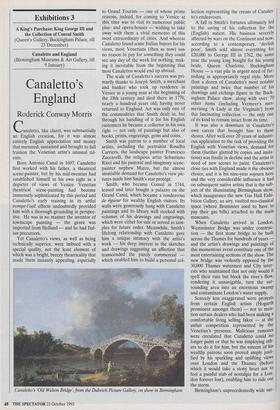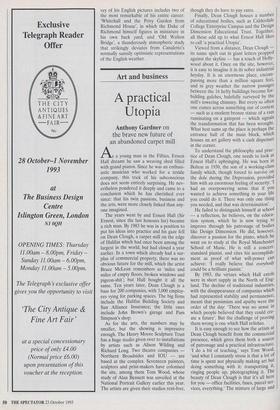Exhibitions 3
Canaletto and England (Birmingham Museums & Art Gallery, till 9 January)
Canaletto's England
Roderick Conway Morris
Canaletto, like claret, was substantially an English creation, for it was almost entirely English appreciation and money that nurtured, sustained and brought to full fruition the Venetian artist's unusual tal- ents.
Born Antonio Canal in 1697, Canaletto first worked with his father, a theatrical scene-painter, but by his mid-twenties had established himself in his own right as a depicter of views of Venice. Venetian theatrical scene-painting had become immensely sophisticated by this period and Canaletto's early training in its artful trompe-roeil effects undoubtedly provided him with a thorough grounding in perspec- tive. He was in no manner the inventor of townscape painting — the genre was imported from Holland — and he had Ital- ian precursors.
Yet Canaletto's views, as well as being technically superior, were imbued with a special quality, not the least element of which was a bright, breezy theatricality that made them instantly appealing, especially to Grand Tourists — one of whose prime reasons, indeed, for coming to Venice at this time was to visit its numerous public play- and opera-houses — wishing to take away with them a vivid memento of this most extraordinary of cities. And whereas Canaletto found some Italian buyers for his views, most Venetians (then as now) saw no reason to pay for something they could see any day of the week for nothing, mak- ing it inevitable from the beginning that most Canalettos would end up abroad.
The scale of Canaletto's success was pri- marily thanks to Joseph Smith, a merchant and banker who took up residence in Venice as a young man at the beginning of the 18th century and died there in 1770, nearly a hundred years old, having never returned to England. Art was only one of the commodities that Smith dealt in, but through his handling of it for his English customers he became a collector in his own right — not only of paintings but also of books, prints, engravings, gems and coins.
Smith was patron to a number of local artists, including the portraitist Rosalba Carriera, the landscape painter Francesco Zuccarelli, the religious artist Sebastiano Ricci and his pastoral and imaginary scene- painter nephew Marco, but the almost insatiable demand for Canaletto's view pic- tures made him Smith's star protégé.
Smith, who became Consul in 1744, leased and later bought a palazzo on the Grand Canal, which became a rendezvous de rigueur for wealthy English visitors. Its walls were generously hung with Canaletto paintings and its library well stocked with volumes of his drawings and engravings, which were either for sale or served as sam- ples for future order. Meanwhile, Smith's lifelong relationship with Canaletto gave him a unique intimacy with the artist's work — his deep interest in the sketches and drawings suggesting an affection that transcended the purely commercial which enabled him to build a personal col- Canaletto's 'Old Walton Bridge, from the Dulwich Picture Gallery, on show in Birmingham lection representing the cream of Canalet- to's endeavours.
A fall in Smith's fortunes ultimately led to the saving of his collection for the (English) nation. His business severely affected by wars on the Continent and now, according to a contemporary, `devlish poor', Smith sold almost everything for £20,000 to George III in 1762, the same year the young king bought for his young bride, Queen Charlotte, Buckingham House — a vast pile in urgent need of fur- nishing in appropriately regal style. More than a dozen of Canaletto's most notable paintings and twice that number of his drawings and etchings figure in the Buck- ingham Palace show, along with over 70 other items (including Vermeer's mes- merising 'A Lady at the Virginals') from this fascinating collection — the only one of its kind to remain intact from its time.
It was also a downturn in Canaletto's own career that brought him to these shores. After well over 20 years of industri- ous application to the task of providing the English with Venetian views, demand for them (further glutted by copies and imita- tions) was finally in decline and the artist in need of new scenes to paint. Canaletto's close ties with England made it the obvious choice, and it is his nine-year sojourn here and the very considerable influence it had on subsequent native artists that is the sub- ject of the illuminating Birmingham show, which inaugurates the new Gas Hall Exhi- bition Gallery, an airy, vaulted neo-classical space (where Brummies used to have to pay their gas bills) attached to the main museums.
When Canaletto arrived in London, Westminster Bridge was under construc- tion — the first stone bridge to be built across the Thames for hundreds of years — and the artist's drawings and paintings of this momentous event constitute one of the most entertaining sections of the show. The new bridge was violently opposed by the 30,000 Thames watermen and City inter- ests who maintained that not only would it spell their ruin but block the river's flow, rendering it unnavigable, turn the sur- rounding area into an enormous swamp and contaminate London's water supply. Scarcely less exaggerated were protests from certain English artists (Hogarth prominent amongst them) — not to men- tion certain dealers who had been making a comfortable living selling fakes — at the unfair competition represented by the Venetian's presence. Malicious rumours were circulated that Canaletto could no longer paint or that he was employing oth- ers to do it for him, but the esteem of his wealthy patrons soon proved amply justi- fied by his sparkling and uplifting views over London and the Thames (before which it would take a stony heart not to feel a painful stab of nostalgia for a Lon- don forever lost), enabling him to ride out the storm.
Birmingham's unprecedentedly wide sur- vey of his English pictures includes two of the most remarkable of his entire career: `Whitehall and the Privy Garden from Richmond House', in which the Duke of Richmond himself figures in miniature in his own back yard, and 'Old Walton Bridge', a thunderously atmospheric study that strikingly deviates from Canaletto's normally sunnily optimistic representations of the English weather.



































































 Previous page
Previous page